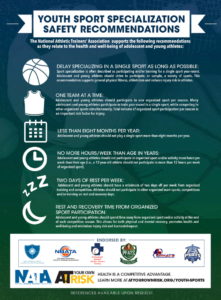by Mitch Hauschildt, MA, ATC, CSCS
I have always had an interest in youth sports and how it impacts children for the better (or worse). This is partly due to what I have always done for a living with regards to sports medicine and injury prevention, but now because I have 4 children of my own who are all active in sports and activities.
Many people assume that because of what I do for a living (creating high level college athletes), that I naturally push my kids to play sports and have high expectations of them with regards to performance. The reality is that I tend to actually shy away from pushing my kids into youth sports. Unfortunately over the years I have seen a lot of the negative side of the youth sports movement.
I have seen kids burn out at an early age and end up hating sports. I have seen young kids sustain troubling injuries at far too early an age. And, I have seen parents and families stressed to the max (physically, emotionally, financially) in an effort to manage the youth sports lifestyle. Seeing this has pushed me back from youth sports and work to figure out how sports fits into my family.
Overall, where I’ve landed as of today is that I strongly encourage my kids to play sports, not because I want to win or because I think that they will get a scholarship some day. I do it because there are huge things to be learned from sports, such as work ethic, leadership skills, working within a team, and how to handle adversity. Youth sports also teaches my children physical fitness and lifelong health skills. We compete and want to win, but we don’t participate in travel teams or over commit ourselves. We work hard to make sure sports time doesn’t trump family time such as our fun times at the lake over the summer. These skills matter for my children far after their sports careers end.
Recently, the National Athletic Trainer’s Association (NATA) released a position statement on how we should be managing youth sports for the long term health and well being of our youth. Their position statement is very well supported by research and supports a number of things that many people in this profession have been preaching for years, but it is definitely affirming to see them put together in an official statement by a very well respected national organization.
Here is a synopsis of the position statement and my thoughts on each area:
- Delay specializing in a single sport as long as possible. We see this every year when we analyze major events such as the NFL draft. Many people fall into the trap that we must focus on one thing to get good at it, but every year we see that somewhere around 30 of the 32 first round draft picks played multiple sports in high school. Having variety in our movement creates better athletes and decreases injury rates.
- One team at a time. This goes right along with this idea of not specializing too early. I will say, though, that in today’s youth sports environment, this is really hard to accomplish. Many developmental teams practice year round or a long time outside of their competitive season. If you aren’t willing to make that commitment, then you can’t be on the team. I’m not even talking about competitive traveling teams. That is just some of your better, local developmental programs that at least take coaching and playing somewhat seriously to try to help kids improve every day. I’m not sure how to solve this one in the “real world”, but it is worth striving for.
- Less than eight months per year. If you can meet the previously mentioned goals, then this is pretty easy to accomplish. The idea is that youth should not be playing more than 1 competitive sport for more than 8 months per year. This is very well researched for preventing injuries in youth.
- No more hours/week than age in years. Between my wife and myself both working and our 4 kids, there is no way that we can commit that much time to any of our kids, but I can see with some sports and programs that it is plausible that 12 year olds might commit more than 12 hours per week to sporting activities, but it hasn’t been a big issue for our situation. This is just a reminder that less is more.
- Two days of rest per week. The thing to point out in this area is that they don’t necessarily suggest that they completely take the days off to rest. Rather, they suggest that children take 2 days off per week of organized sports. This means that they can be active (and probably should be), but it should come in the form of them enjoying playing something fun on their own that isn’t organized.
- Rest and Recovery time from organized sport participation. This is also very difficult in our current youth sports world because most seasons overlap. The seasons continue to get a little longer and a little longer and now football runs into basketball which runs into baseball and on and on. I agree with the goal, but it is a challenge to accomplish for sure.
Overall, if you want a healthy son or daughter with a great outlook on sports long term, these are some great guidelines to consider. I don’t know if you need to check every box for every kid, but the more you can meet, the better, as a general rule.
Thanks to the NATA for diving into this important topic and compiling the data into a statement that makes sense.


Leave a Reply